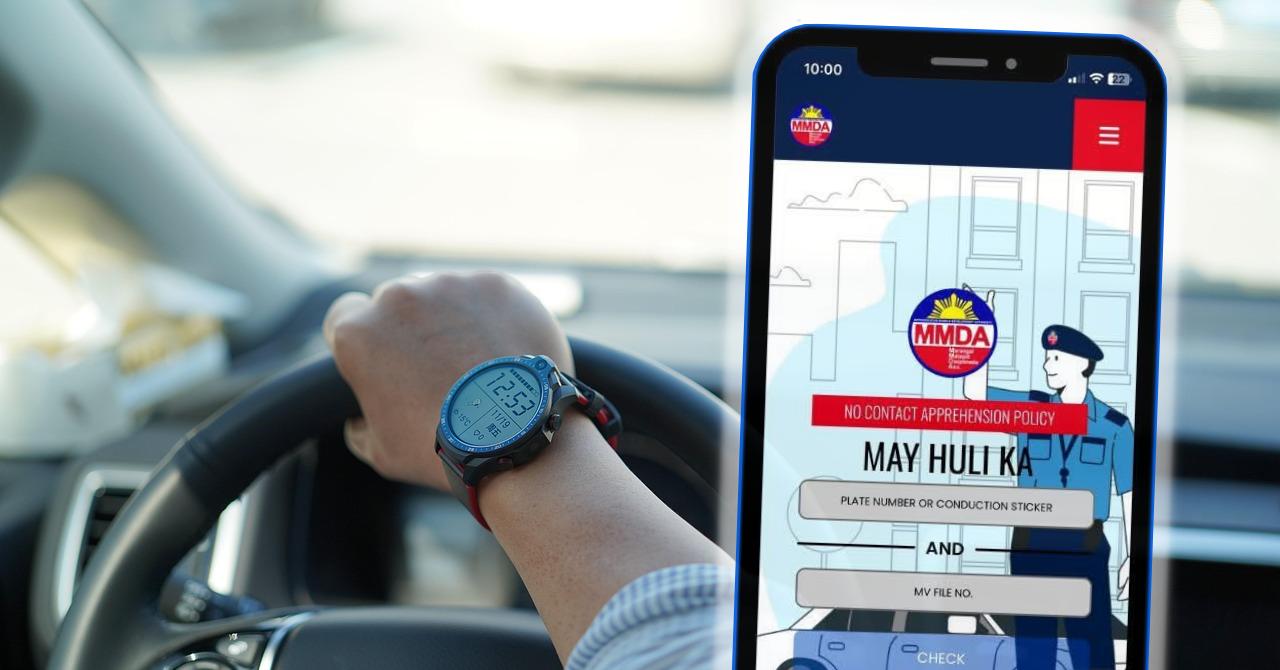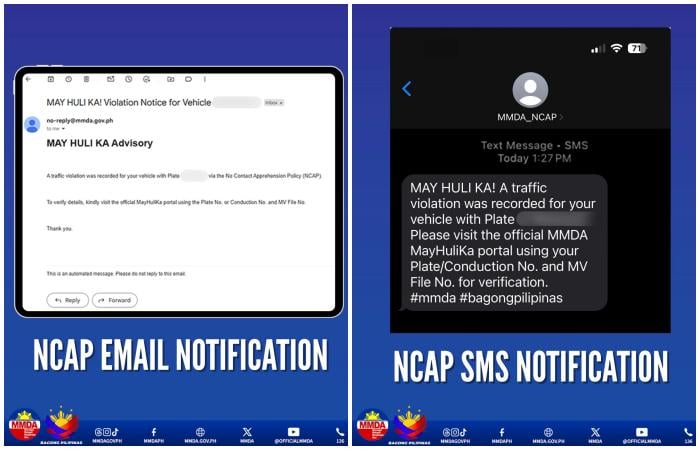These days, it’s no secret that the Metro Manila Development Authority (MMDA) and other authorities have been following the No Contact Apprehension Policy (NCAP) to manage traffic and catch road violations. Since this program makes use of speed cameras, how can you know if you’ve committed any violations?
To address this concern, the MMDA introduced an online portal for motorists to check if they’ve broken any rules on the road. Dubbed as “May Huli Ka 2.0,” the website was launched last June 16, 2025 at the MMDA Head Office in Pasig City, Metro Manila.

Guide to Checking NCAP Violations Online
What exactly is NCAP, how does it work, and how can motorists use the “May Huli Ka 2.0” website to check if they have any traffic tickets? Here is an overview of the program and the new website:
What is NCAP?
The No Contact Apprehension Policy (NCAP) is a program that involves the use of high-definition CCTV cameras, digital cameras, and other devices to catch those who’ve committed road or traffic violations. It was based on MMDA Resolution 16-01, s. 2016.
As the term “no contact” implies, the program enables traffic management agencies to identify and apprehend violators, even without the presence of an traffic enforcer onsite. In this manner, instances of extortion by (and bribery of) enforcers are reduced, while traffic congestion is avoided at the same time.
Where is NCAP Implemented?
In 2016, the MMDA started implementing NCAP along the major thoroughfares of Metro Manila, placing CCTV traffic cameras in strategic locations, including: Recto, Mendoza, Pres. Quirino Avenue, Araneta Avenue, EDSA, C.P. Garcia, Katipunan Avenue, Tandang Sora, Roxas Boulevard, Taft Avenue, South Super Highway, Shaw Boulevard, Ortigas Avenue, Magsaysay Boulevard, Aurora Boulevard, Quezon Avenue, Commonwealth Avenue, A. Bonifacio, Rizal Avenue, Del Pan, Marcos Highway, and McArthur Highway.
Notably, other local government units (LGUs) have also begun enforcing their own “versions” of NCAP. Among these are Parañaque City, which started implementing a fully unmanned traffic apprehension system in 2018; and Valenzuela City, which launched its own NCAP program in 2019.
Likewise, in 2011, Cauayan City in Isabela Province began implementing a No Contact Apprehension Program on its major roads, making it the first city outside Metro Manila to adopt NCAP. In the same year, Bataan Province launched its own NCAP program, focusing on the Roman Superhighway, its main thoroughfare.
In the future, we can expect more cities, towns, and provinces all over the Philippines to adopt and implement NCAP as a traffic management tool!
How NCAP Catches Violations
How exactly does NCAP catch traffic violators? Here’s a step-by-step description of the process:
- First, a CCTV camera/digital camera catches a traffic violation.
- Secondly, the violation is reviewed by traffic officials and monitoring staff.
- Next, the vehicle’s registration records are verified through the Land Transportation Office (LTO) Information Query Facility.
- Verified information about the vehicle is encoded in the NCAP System.
- A Notice of Violation (NOV) ticket is printed.
- The NOV ticket is sent via PhilPost to the vehicle owner (for private vehicles) or the bus company (for buses).
NOTE: On July 7, 2025, the MMDA launched short message service (SMS) and email notifications for NCAP. Hence, vehicle owners will receive notifications immediately, even if they don’t have Internet connection. This will allow them to resolve the matter more quickly!

What is May Huli Ka 2.0?
Recently, the MMDA introduced “May Huli Ka 2.0,” an online portal where owners can check if they have any traffic violations. The website also provides information on procedures, such as where and how to make payments, as well as how to contest an apprehension.
Interestingly, the website is an “upgrade” from a previous version, with the inclusion of the Motor Vehicle (MV) file number for added security and privacy. Through this feature, only vehicle owners can check their traffic violations, unlike in the old system where anyone with a license plate number can view information about a vehicle.
How to Check NCAP Violations
Using the “May Huli Ka 2.0” online portal involves several steps, mainly: (a) searching for traffic violations; (b) verifying them; and (c) paying fines or filing an appeal.
Search for Violation
To see if you have any traffic tickets or violations, visit the “May Huli Ka 2.0” official website. Enter your license plate number or conduction sticker, and also your MV file number. Click “check.”
Verify Violation
If the screen shows that you have a registered violation, you can verify it by requesting a copy of the NOV ticket through email. That being said, you will also receive a copy of the NOV ticket via PhilPost.
Pay Fine
Be sure to settle your fine within ten (10) working days upon receiving your NOV ticket. To make a payment, you can go personally to the MMDA Head Office in Pasig City (see address below), or to the MMDA Satellite Office in Robinson’s Galleria.
Another option is to make a digital payment. You can settle your fine through Maya, iCash, Bayad App, or Landbank LinkBizPortal.
Contest Fine
If you believe that there’s been a mistake and you did not commit any traffic violation, you can file a protest at the MMDA Traffic Adjudication Division (TAD). Make sure you do this within 10 days of receiving the NOV; otherwise, failure to file a protest within this period will be seen as a waiver of your right to contest the violation.
If the TAD agrees that you did not commit a traffic violation, then that’s settled! However, if the TAD issues a resolution stating that you did commit a traffic violation, you have 15 working days to file another appeal — this time, to the Office of the MMDA Chairman. The decision of the Chairman regarding your case will be final and executory, and no further appeals may be made afterwards.

Upcoming Features
Like other digital technologies, the “May Huli Ka 2.0” website will continue to be upgraded from time to time. In fact, MMDA officials state that it will have several upcoming features, as follows:
- Access to more detailed traffic violation information (i.e. date and time of violation, type of violation, photo and video evidence, corresponding fines, and settlement locations);
- Ability for users with multiple vehicles or fleets to enroll all of their vehicles under a single account; and
- Online processes for payment integration, filing contest/appeal cases, and hearing schedules.
Frequently Asked Questions (FAQs)
Meanwhile, here are some commonly asked questions — and answers — regarding the NCAP program:
1. Will NCAP replace MMDA traffic enforcers?
No, the NCAP program is designed to supplement and not replace MMDA traffic enforcers, who are still deployed in roads across Metro Manila, especially in areas that are not yet covered by CCTVs.
2. Will traffic violation tickets be doubled because of NCAP?
No, the MMDA ensures that traffic violation tickets will not be doubled. Traffic enforcers onsite regularly submit their tickets, which are cross-checked with violations that are captured by CCTVs
3. What if a violator refuses to receive the NOV ticket?
A traffic violator who refuses to receive the NOV ticket without any valid reason will be considered to have received it. A copy of the ticket will be left with him/her, and a report attesting to the violator’s refusal to receive the NOV will be submitted to the MMDA.
4. What happens if a violator doesn’t pay the fine?
If a violator does not settle the fine within 10 working days from receiving the NOV ticket, the vehicle’s license plate number will be included in the “Alarm” list. When the time comes for the vehicle’s registration to be renewed at the LTO, payment will be required.
5. What if a violation has been committed by the new (but not the registered) owner of a vehicle?
In some cases, a traffic violation may have been committed by a vehicle’s new owner before a “transfer of registration” is made, so the NOV traffic ticket is sent to the previous (registered) owner.
If this is the case, the previous owner may contact the NCAP office and submit a notarized Deed of Sale, along with the name and address of the new owner. The Deed of Sale will serve as proof that he/she is no longer the owner and/or user of the vehicle.
Contact Information: No Contact Apprehension Office
For queries and concerns about NCAP, you can get in touch with the “No Contact Apprehension Office,” which is located in the MMDA Head Office. Here are the office’s contact details:
Address: 2F Doña Julia Vargas Ave, Ortigas Center, Pasig, Metro Manila
Telephone: (02) 8898 4200 loc. 1084
Email: noncontact@mmda.gov.ph / ncap2@mmda.gov.ph
Website: https://mmda.gov.ph/ / https://mayhulika.mmda.gov.ph/
Facebook: https://www.facebook.com/MMDAPH/
Google Map:
Through NCAP — the MMDA, LGUs, and other agencies are truly utilizing digital technology to improve the country’s transportation and traffic management systems. It goes in line with the directives of President Ferdinand Marcos Jr., who is committed to enhancing public services through “digitization” and new technologies.
Speaking of traffic rules, here’s a list of driving fines and violations that are currently being implemented throughout the country. Remember to follow these rules at all times, so that you won’t have to face or pay for any traffic violations!